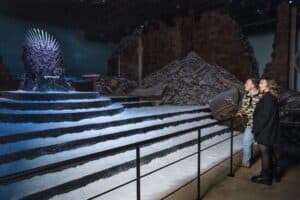At the time of construction, the Titanic was the largest and most ambitious commercial liner in the world. Commissioned and operated by the White Star line, the ship’s purpose was to transfer passengers across the Atlantic in an opulent fashion. This incredible vessel has strong connections both with locations on the island of Ireland and with her people
Belfast
The Titanic was built at the Harland and Wolff shipyards in Belfast, a thriving industrial city at the time. Initially conceptualized in 1907 and designed by County Down native Thomas Andrews, the Titanic’s construction began in 1909 and continued for 3 years. The project gave a great boost to the Belfast economy and led to the city being nicknamed “Boomtown Belfast”. Over 3,000 jobs were created by the endeavor, however health and safety standards were poor at the time so there were many casualties during the construction phase. Six people lost their lives, five of whom were Irish. Among them was Samuel J. Scott who was just 15 years old.
designed by County Down native Thomas Andrews, the Titanic’s construction began in 1909 and continued for 3 years. The project gave a great boost to the Belfast economy and led to the city being nicknamed “Boomtown Belfast”. Over 3,000 jobs were created by the endeavor, however health and safety standards were poor at the time so there were many casualties during the construction phase. Six people lost their lives, five of whom were Irish. Among them was Samuel J. Scott who was just 15 years old.
When you visit Belfast today, you’ll find great opportunities to learn more about the city’s shipbuilding roots with much Titanic history to uncover. The Titanic Belfast attraction boasts an award-winning walking tour exploring the symbolism of the events and the stories of the men who built the ship. Set foot in the shipyard where it all began and get an inside look as you learn about the design, construction and operation of the ship. Titanic stories dispel the myths and clarify the events by explaining previously unknown aspects of the story.
Cobh
After setting out from Southampton, the ship picked up its next group of passengers in Cherbourg, France. From there, the Titanic moved toward its final stop in Cobh, County Cork. The vessel stopped off the coast of what was then known as Queenstown to pick up its final  passengers. The harbor was not big enough to hold the huge ship, so smaller ships were used to bring passengers aboard. Thousands of locals came to see off the vessel, which at the time was the largest passenger liner on the open seas. From Cobh, the Titanic set sail for New York City but would sadly find it’s final resting place at the bottom of the Atlantic. Titanic Cobh offers an authentic experience where you can walk in the footsteps of the final 123 people to board, including an immersive cinematographic emulation of the sinking of the ship. Stand on the last point of land contact for the Queenstown passengers known as Heartbreak Pier. Your personal tour guide takes you on a virtual journey to board the tenders and join the Titanic for her Maiden voyage. The tour finishes up in the story room where you find out if the real-life character you’ve been assigned survived the disaster.
passengers. The harbor was not big enough to hold the huge ship, so smaller ships were used to bring passengers aboard. Thousands of locals came to see off the vessel, which at the time was the largest passenger liner on the open seas. From Cobh, the Titanic set sail for New York City but would sadly find it’s final resting place at the bottom of the Atlantic. Titanic Cobh offers an authentic experience where you can walk in the footsteps of the final 123 people to board, including an immersive cinematographic emulation of the sinking of the ship. Stand on the last point of land contact for the Queenstown passengers known as Heartbreak Pier. Your personal tour guide takes you on a virtual journey to board the tenders and join the Titanic for her Maiden voyage. The tour finishes up in the story room where you find out if the real-life character you’ve been assigned survived the disaster.
Irish People
It’s reported that 110 Irish people lost their lives on the Titanic. Among them was first class passenger Edward Pomery Colley, who died on his 37th birthday. However, 54 of the Irish on board the Titanic did survive. One particularly lucky passenger named Francis Brown disembarked the vessel in Cobh bringing with him some incredible photos of the ship.
There’s a remarkably deep and interesting story surrounding the manufacturing and eventual demise of this magnificent vessel. If you’re visiting Ireland, it’s highly recommended to check out the Titanic attractions in both Belfast and Cobh. Our East-Coast Excursion self-drive tour starts in Belfast and finishes in Cobh, so it’s a great way to see all of Ireland’s Titanic related attractions. The tour takes place over 9 days and includes visits to Carlingford Lough, Newgrange and the Wicklow mountains to name but a few. Follow the link to see the full list of great destinations and first class accommodations included in this tour.





